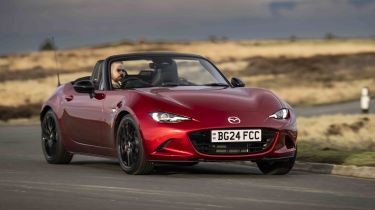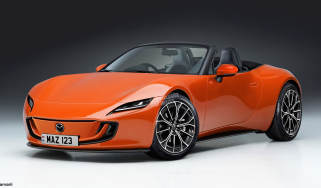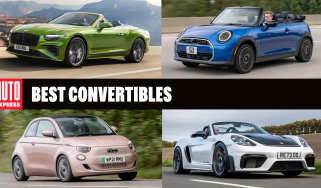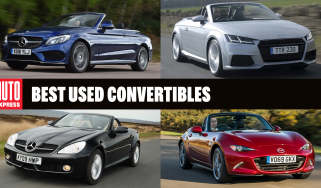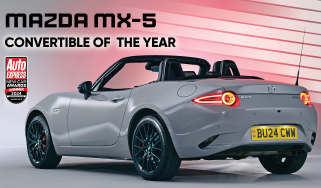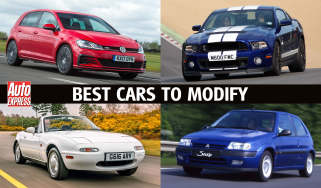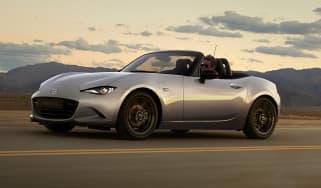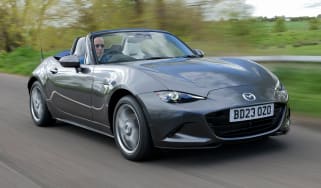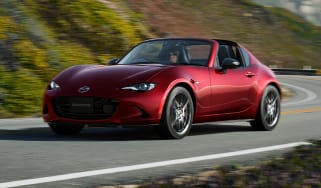Mazda MX-5 review
Mild updates to the Mazda MX-5 mean that the world’s best-selling roadster is getting even better with age

Is the Mazda MX-5 a good car?
At a time when cars are becoming heavier, larger and ever more complex, the appeal of a small, simple, lightweight sports car grows stronger with every passing year. And with the Mazda MX-5 gaining some small but significant updates for 2024, it’s no wonder that we named it our Convertible of the Year.
Not only is there just enough tech to keep things feeling fresh inside, but the most potent 2.0-litre model is better to drive than ever before. For pure driving thrills on a fairly modest budget – helped by low running costs – the MX-5 is very hard to beat.
| Key specs | |
| Fuel type | Petrol |
| Body style | Sports car |
| Powertrain | 1.5-litre 4cyl petrol, rear-wheel drive 2.0-litre 4cyl petrol, rear-wheel drive |
| Safety | 4-star Euro NCAP (2015 - rating expired) |
| Warranty | 3-years/60,000 miles |
How much does the Mazda MX-5 cost?
Ever since the Mazda MX-5 launched back in 1989 as a spiritual successor to British classics like the Lotus Elan, it has always been positioned as an affordable, accessible sports car for the masses. Now in its fourth hugely successful iteration (which itself has had a series of updates since its 2015 launch, most recently with a facelift in 2024), its prices start from around £28,000 – or roughly the same as a high-spec family hatchback – so it still fits its original billing today.
That price is for the 1.5-litre, 130bhp petrol model in base Prime-Line trim; the 2.0-litre petrol lifts that output to 181bhp, but is only available in the higher two trim options. As a result, it kicks off from around £32,000 in Exclusive-Line form, and tops out at roughly £35,000 for the Homura. If you need the extra security of an electrically folding metal roof, then the RF model costs around £2,000 more than the soft-top. Given this extra price point, and the fact that, roof-down, pronounced buffeting around the rear buttresses makes it noisier than the roadster, we’d save our cash.
Used - available now
Very much in keeping with the simple nature of a sports car like this, all versions send drive to the rear wheels via a six-speed manual gearbox. The 2.0-litre models get other mechanical benefits beyond the extra power, too. The key stand-out feature is the limited-slip differential, which was revised as part of a mild facelift for the MX-5 range in 2024. A new cam mechanism within the differential has allowed Mazda to adjust how it behaves both off the throttle when entering a corner and when getting back on the power on corner exit to the benefit of more predictable, yet still agile, handling.
Engines, performance and drive
Back-to-basics driving thrills are what the Mazda MX-5 has always been about – and the latest version doesn’t disappoint. Despite its price, it’s a driver’s car that deserves to be mentioned in the same breath as much more expensive performance cars, including the Porsche Boxster and the Alpine A110.
| Model | Power | 0-62mph | Top speed |
| 1.5L SKYACTIV-G Roadster | 130bhp | 8.3 secs | 127mph |
| 1.5L SKYACTIV-G RF | 130bhp | 8.7 secs | 126mph |
| 2.0L SKYACTIV-G Roadster | 181bhp | 6.5 secs | 136mph |
| 2.0L SKYACTIV-G RF | 181bhp | 6.8 secs | 137mph |
What is the Mazda MX-5 like to drive?
In town
Even at low speeds, it’s a hugely pleasurable thing to drive; from the pedals to the steering to the gearbox, all of the major controls are wonderfully weighted and superbly precise. It’s a car that allows you to appreciate the basics of mechanical interaction on even a short trip to the shops.
Harsher bumps can cause these small, light cars to jostle around at low speeds. It’s at these lower speeds that roof-off driving in either model results in a little flex from the chassis, which manifests itself most obviously through vibrations in the rear view mirror.
On A- and B-roads
It’s on more open roads where the MX-5 really starts to shine, though. With a kerbweight of between 975kg and 1,000kg depending on spec, the Mk4 is over 100kg lighter than the third-generation model, and only 50kg heavier than the original launched back in 1989.
The result is a wonderful chassis, granting the driver a feeling of agility and balance that with every passing year becomes even easier to appreciate as so many cars grow heavier and larger and more ponderous.
The suspension is much more supple than a typical hot hatch, so the car flows along a bumpy road and rolls through the corners. This allows the driver to feel just what is going on through not only the seat of their pants, but also the electric power-steering system; revised for 2024, it has become more naturally weighted than ever before. It doesn’t take too much commitment to play with the car’s limits of grip; normally by throwing it into a bend enthusiastically. Even when the front starts to slide, the mildest throttle lift and a little extra lock will see the car tighten its line further. It’s all so predictable and reassuring – and all happening at such sensible speeds that it inspires a huge amount of confidence, so you only lean on it harder.
Another new-for-’24 feature that helps with this is a revised limited-slip differential. A new cam mechanism has enabled different levels of slip for acceleration and deceleration; in short, what this means is that Mazda has been able to tune the diff to make the car more predictable on the limit.
As before, the differential is only available on the top 2.0-litre model. The 2.0-litre also has bigger brakes than the entry-level 1.5-litre petrol, which deliver better stopping power, plus gets sports suspension with Bilstein dampers and a front strut brace. These reduce body roll and aid turn-in. The 2.0 car is slightly heavier than the 1.5, but only by 25kg. The added weight is in the nose and as a result the 2.0-litre doesn’t feel quite as quick to turn in, even though it's been given a strut brace to keep the suspension tied together.
Like the roadster, the MX-5 RF has a fairly soft overall suspension set-up which allows the driver to flow with the road. The RF also weighs an extra 40kg over the standard car – most of which is fairly high up in the chassis. While this is noticeable when driving the two variants hard and back-to-back – and the 0-62mph times are marginally slower than the lighter roadster variants – most people won’t notice too much difference. However, given the price difference and the fact that in some ways it’s less refined, we’d aim for the soft- top instead.
On the motorway
Perhaps more of a surprise is that, despite the extra metal that surrounds the driver, the RF is the less refined car on the move; the wind tends to catch the upright buttresses behind the driver and passenger, which at motorway speeds generates far more wind noise than the convertible’s more open design. That aside, the MX-5 is a fairly comfortable and relaxing long-distance cruiser, roof up or down.
0-62mph acceleration and top speed
We’ve never craved more power in the MX-5, but with the chassis now better than ever, it’s clear that it could quite reasonably handle more than the 181bhp and 205Nm (at 7,000rpm and 4,000rpm respectively) that’s available here. A 0-62mph time of 6.5 seconds isn’t sluggish, though, but this car is more about conserving momentum – even more so in the 1.5-litre petrol.
Despite a modest 130bhp (again at 7,000rpm) and 152Nm at 4,500rpm, the MX-5’s light weight pays dividends here, giving better performance than you might expect – 0-62mph takes 8.3 seconds. Top speed is 127mph. It’s a lively unit that needs plenty of revs to get to its best – something that it is more than happy to do thanks to its 7,500rpm red line and, as is the case in the 2.0-litre, a fantastic six-speed manual gearbox that is precise and has a wonderfully short throw.
The hard-top RF is available with both engines, but being slightly heavier it takes 8.7 seconds and 6.8 seconds to go from 0-62mph in 1.5 and 2.0-litre forms, respectively.
Whichever you go for, the two engine choices make a revvy, angry noise and just enough exhaust note enters the cabin to remind you that you’re in something sporty. The 1.5 is a little freer revving, but deciding which version has the better character will come down to personal preference.
MPG, CO2 and running costs
Mazda claims it prefers not to focus on achieving spectacular results in the official EU economy cycle; instead, it says it’s more interested in giving customers real-world fuel savings.
That’s why its strategy is based around high-compression naturally aspirated petrol engines rather than following the turbocharged, downsizing trend. Both the engines offered in the MX-5 use direct injection technology, but the smaller 1.5-litre SkyActiv unit delivers better economy – it returns 45.6mpg with CO2 emissions of 140g/km.
The 2.0-litre comes with Mazda’s i-stop and E-Loop fuel-saving technology. According to Mazda it emits 153g/km of CO2 and can only return 41.5mpg at best, although that seems fairly conservative to us – mid-40mpg should be easily achievable, but you’ll need it to be frugal when the MX-5 only comes with a 45-litre fuel tank.
Despite its exotic shape, the MX-5 should be no more expensive to run than, say, a Mazda 3 hatchback – both use a variety of common components, so replacement parts should be easy to track down and relatively affordable.
| Model | MPG | CO2 | Insurance group |
| MX-5 1.5 Exclusive-Line | 45.6mpg | 140g/km | 27E |
| MX-5 2.0 Exclusive-Line | 41.5mpg | 153g/km | 33A |
Tax
From the second year onwards, the MX-5 is subject to VED charges of £190. A 33 per cent banding in the Benefit in Kind ratings for even the base 1.5-litre petrol makes it a pricey company car, with base rate taxpayers facing deductions of roughly £2,000 a year.
Insurance groups
The hard-roofed RF has slightly lower insurance groups than the soft-top models. That means the lowest grouping is the base 1.5-litre Prime-Line RF at 24, while the highest group is for the top-spec 2.0-litre Homura roadster, which comes in at group 33.
Depreciation
Despite the UK’s love for a convertible, the MX-5 doesn’t hold its value as well as you might expect. Depending on the version, our experts predict that it’ll maintain between 39 and 42 per cent of its original value after three years and 36,000 miles, which is a little below the market average.
To get an accurate valuation for a specific model, check out our free car valuation tool...
Interior, design and tech
For 2024, there have been extremely subtle design changes to the outside of the Mazda MX-5, with both the head and tail lights gaining revised LED lighting graphics. It’ll take the largest of anoraks to spot those differences, though. A new paint option, called Aero Grey, was also added, though we’re still big fans of the gorgeous Soul Red finish.
Slim LED headlights and a gaping front grille give it a slightly more menacing character than the third-generation model, while round tail lamps provide a striking light signature in the dark. Whether the roof is up or down, the MX-5 has a classic silhouette, with the cockpit located towards the rear of the car and a long bonnet stretching out in front.
By adapting the standard MX-5’s design to accommodate the hard roof on the RF, Mazda has created something really rather unique in this sector. Unlike the Mk3 MX-5 RC, the RF has buttresses that slope down from the back of the cabin and into the slightly kicked up rear wheel arches. The result is something discernibly different from its soft-top relative, despite sharing the same sharp-looking front-end design.
What is the Mazda MX-5 like inside?
Inside, one change for 2024 is easier to spot than those external revisions – at least on the top-spec Homura models: a set of new Recaro seats. These seats are trimmed in leather and Alcantara, and give a fantastic driving position; they help the driver to feel even more connected to the action than before.
What is the interior quality like?
Whichever model you go for, on the inside the door tops are coloured to match the exterior paint, adding a flash of colour to the cabin and, according to Mazda, visually connecting the driver to what’s going on outside. They are also sculpted in such a way that airflow with the hood down is directed to keep the passengers cool while minimising buffeting to their hairstyles. Meanwhile the instrument panel (with the tachometer front and centre) and air vents are designed to be perfectly symmetrical around the driver, for a cockpit-style feel.
Apart from a few questionable plastics here and there, and the simplicity of its design, the MX-5 cabin is a pleasant place to be.
Sat-nav, stereo and infotainment
Another key improvement for ‘24 is the introduction of an updated infotainment system. This includes a new 8.8-inch touchscreen – although it only responds to touches when the car is parked. On the move, it’s still possible to use the same intuitive click wheel arrangement that was previously featured. The screen is larger and sharper than before – all the better for reading the on-screen map, and more up-to-date USB-C ports have been added, too.
Despite this change, physical dials for the air-conditioning controls have been maintained; they’re large and very easy to use. Wireless Apple CarPlay and Android Auto are available, and we found it easiest to pair the phone with a USB cable the first time, at which point the system remembers the device wirelessly for subsequent journeys. For the most part, it’s a logical system, but we would like a shortcut to more easily disable the slightly irritating lane departure warning system. A speed limit chime can be switched off with a physical mute button to the right of the steering wheel, just beside the traction control button.
Boot space, comfort and practicality
While the Mazda MX-5 will never be a family car, it has definitely made the most of its limited dimensions. The lightweight fabric hood can be folded back easily from the driver’s seat with one hand. Small cubbies between the seats and on the centre console are useful for your phone or small change, while the car's 12v socket is tucked away under the dash in front of the passenger seat. However, the door bins are small and there’s no glovebox in the MX-5, bizarrely.
A bonnet lowered by 28mm over the previous car’s, plus thinner A-pillars moved back by 70mm, mean forward visibility has been improved significantly. But what really makes the MX-5 surprisingly practical is its light steering feel, soft suspension and impressive refinement with the roof up in top gear.
The metal roof of the Mazda MX-5 RF can be raised or lowered in 13 seconds, at up to 6mph. However, the clever top reduces boot space by three litres over the standard convertible, to 127 litres. The hard-top doesn’t dampen wind noise any more than the canvas-roofed MX-5, so the RF is still noisy. There is some turbulence, despite a wind deflector.
It all adds up to a car that you could easily use every day, unless you need to carry large, bulky items on a regular basis.
| Dimensions | |
| Length | 3,915mm |
| Width | 1,735mm |
| Height | 1,225mm |
| Number of seats | 2 |
| Boot space | 130-litres (127-litres RF) |
Dimensions and size
The Mazda MX-5 is compact, to say the least. It’s less than four metres long (3,915mm), just 1,735mm wide including the door mirrors and 1,225mm high (1,230mm with the 17-inch wheels fitted). The overhangs are shorter than before, and the wheelbase is trimmed to 2,310mm, which requires inventive packaging within, yet also provides the squared-off stance of the MX-5.
How practical is the Mazda MX-5?
Seats & space in the front
Compared with its predecessor, the seats in the latest Mazda MX-5 have been moved closer together, with two six-foot adults on board the driver will occasionally brush their passenger’s thigh inadvertently when changing gear. But otherwise, the MX-5 is very comfy inside for a small car.
With the roof up, headroom stands at 950mm, there’s over a metre of leg room (1,096mm), and you get 1,325mm of shoulder room and 1,320mm of hip room across the cabin. Put simply, it’s cramped in the MX-5, and the RF offers marginally less headroom than the soft-top. So it’s not as spacious as a Toyota GR86 or Toyota GR Supra, but for something markedly cheaper than those rivals it still feels an appealing, premium product. Plus, when the conditions are right and you can take the roof off, you won’t be concerned about headroom anymore.
Seats & space in the back
The Mazda MX-5 is a sports car with no space in the back for additional seating. If you’re after an drop-top car with space for four, you’ll need to look at something different, such as the Fiat 500e Convertible, or more expensive, such as the Porsche 911 Cabriolet.
Boot space
Boot space is reduced over the old model by 20 litres to 130 litres overall, but cleverly the load area has been reshaped so that it can swallow two carry-on suitcases – something that the old model could not achieve. The boot opening is 821mm above the ground, while the fabric hood stows away in a slot behind the rollover hoops, so it doesn’t eat into the limited luggage capacity. The hard-top RF has even less boot space – just 127 litres.
Reliability and safety
The latest Mazda MX-5 still retains a relatively simple mechanical layout, as well as plenty of electronic kit shared with existing models, so the car should provide trouble-free motoring. It’s worth noting, however, that if you plan to drive it hard – on road or track – then perishables such as brake discs, brake pads and tyres will need replacing more frequently.
The two-seat roadster didn't feature in our 2024 Driver Power owner satisfaction survey, but Mazda finished in a solid 7th place finish out of 32 best manufacturers, one place ahead of Toyota. Owners praised numerous areas, with the infotainment being a particular highlight.
Safety experts Euro NCAP gave the MX-5 a four-star crash test rating in 2015. The MX-5 missed out on the full five-star score because active city stop wasn’t standard, but every model does get front and side airbags, Dynamic Stability Control and traction control. Upgrading to Exclusive-line or Homura trim adds Lane Departure Warning, Smart City Brake and a Driver Attention Alert system.
However, it is worth noting that because the MX-5 was tested so long ago, its Euro NCAP rating expired in January 2022, and because of the changes made to the organisation's testing procedure the Mazda might not receive the same four-star rating today if it were retested.
| Key standard safety features | Euro NCAP safety ratings |
|
|
Warranty
Mazda offers a standard three-year, 60,000-mile warranty on the MX-5. These days, with some companies offering four, five or seven years of cover, this is about average. Like many three-year policies, it can be extended for a fee, but this additional peace of mind is provided by a third party and a car will need to have less than 100,000 miles on the clock to qualify for an upgrade.
Servicing
Service intervals for the MX-5 are every 12,500 miles or annually, whichever comes first. Mazda offers a three-year service plan which is available for £759 up-front, or paid over monthly instalments.
Mazda MX-5 alternatives
Sports cars like the MX-5 are becoming incredibly scarce on the new car market. While models such as the Porsche 718 Boxster and BMW Z4 deliver open-top, two-seat thrills, both are significantly more expensive than the Mazda. And while both are available on the used market for similar money and are huge talents in their own right, neither has quite the same level of no-frills fun that you’ll find here. If you don’t need the feeling of wind in your hair, then the Alpine A110 is another similarly pure – but much more pricey – driver’s car.
